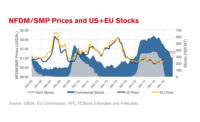Milk prices in EU at an all-time high, yet production grows in 2023
Green Deal target to become climate neutral hits roadblocks since no specific agricultural goals established by 27 individual members.

Photo courtesy of NVS on www.gettyimages.com

In May of 2022 I was at a conference in Germany and the question I asked everyone was, “how high do milk prices have to go to get EU milk production growing again?” Production had been below year ago for nine consecutive months at that point. The answer that I got from nearly everyone was, there wasn’t a milk price that will get milk production growing again.
It turns out that there was a milk price that could get production growing again. Partially thanks to the weak milk production, milk prices in Europe hit record highs in late 2022, and the milk supply has expanded during 2023. So why was everyone so pessimistic about production in early 2022?
The EU Commission presented the Green Deal in late 2019 with the goal of becoming a climate neutral continent by 2050. The Green Deal sets targets for reductions and changes across all sectors of the economy, but specifically for agriculture the goals by 2030 are: 35% reduction in greenhouse gas emissions, 20% reduction in the use of fertilizers, 50% reduction in use and risk of pesticides, 50% reduction in the sale of antimicrobials, 25% of the land in organic products, and 10% of current agricultural land set aside for biodiversity.
With those types of targets looming over the industry, it is easy to see why people were pessimistic on a recovery for milk production, and from a long-run perspective I think the industry is still pessimistic.
One of the most frustrating parts of analyzing the Green Deal is that it will be up to the individual member states to determine how to meet the reductions within their countries, so the policies are going to be a little different in each of the 27 members. As of mid-2023, very few countries have put forward their specific plans to meet these targets. Ireland made headlines earlier this year when some details of a planning document from the Irish Department of Agriculture leaked with a plan to subsidize the slaughter of 200,000 dairy cows to help meet the target. In May the government of the Netherlands won approval to use 1.47 billion euros to buy out farms near environmentally sensitive areas. Those buy outs are specifically tied to reducing nitrogen emissions but will also count toward the Green Deal targets. Details on plans for other countries are still limited, but with just six-and-a-half years before the 2030 deadline, things will have to start moving more quickly.
It is very hard to say exactly what the impact of these policies is going to be or exactly when they will be implemented but farming in Europe will be harder and more expensive in the future. If you were a dairy farmer in this scenario, would you be willing to invest in building a new barn, installing new equipment, or taking out a large loan to buy your retiring neighbor’s land to expand your farm? Farmers have to be optimists to survive, but it is hard to be optimistic with the impending tightening of regulations hanging over your head.
Sitting in the U.S., I can see reasons to be optimistic in the long-run. Feed additives that reduce enteric emissions (burps) from cattle are quickly finding their way to the market. Improving genetics and a focus on squeezing as much milk out of the remining cows as possible will boost milk production per cow. The regulations will force the remaining farmers to get more efficient overall.
Farmers will do their best to survive with the new constraints but between now and 2030 it looks like governments in Europe will be making a concerted effort to reduce the number of cows and milk production in the region. We can still see short-term bumps higher like we are seeing in 2023, but there are significant medium-term headwinds for production in the EU.
This material should be construed as market commentary, merely observing economic, political, and/or market conditions, and not intended to refer to any particular trading strategy, promotional element, or quality of service provided by the FCM Division of StoneX Financial Inc. (“SFI”) or StoneX Markets LLC (“SXM”). SFI and SXM are not responsible for any redistribution of this material by third parties, or any trading decisions taken by persons not intended to view this material. Information contained herein was obtained from sources believed to be reliable, but is not guaranteed as to its accuracy. Contact designated personnel from SFI or SXM for specific trading advice to meet your trading preferences. These materials represent the opinions and viewpoints of the author, and do not necessarily reflect the viewpoints and trading strategies employed by SFI or SXM.
Looking for a reprint of this article?
From high-res PDFs to custom plaques, order your copy today!





.jpg?height=200&t=1623938483&width=200)